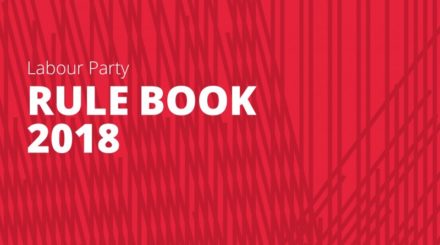
Today Labour’s NEC members are discussing the latest draft of the democracy review proposals, a document sent to them by email on Saturday and seen by LabourList. These will have to be approved by the NEC before being recommended to conference and passed by delegates. Here is a rundown of the most significant suggestions.
Members’ Rights
Clause II will be created to act as a ‘Charter of Members’ Rights’. It emphasises the party’s responsibility to accept self-definition, “when made in good faith”.
Local Structures: CLPs
Executive officers are limited in the rulebook to “chair, vice-chair, vice-chair/ membership, secretary, treasurer, women’s officer”. This would add other officers – “Policy Officer, BAME Officer, Disability Officer, LGBT+ Officer, Trade Union Liaison Officer, Political Education Officer, Communications and Social Media Officer,” that are only functional positions currently. This could change the balance of many CLPs’ executive committees.
Local Government
Replace Local Campaign Forums (LCFs) with Local Government Committees (LGCs). Membership of the LGCs would be made up of:
- 75 per cent of delegates representing the relevant CLPs and 25 per cent of delegates representing affiliated trade union branches; or
- two thirds CLP delegates and one third trade union delegates; or
- 40% CLP delegates, 20% trade union delegates and 40% Labour Group delegates
- all Labour Group members as automatic delegates.
As LCFs do, LGCs would formulate election manifestos in consultation with the Labour group and relevant CLPs. It must also organise annual meetings open to all local members to consult on policy. Unlike with LCFs, “arrangements with other parties” (i.e. council coalitions) must gain the approval of the LGC as well as the NEC.
Sitting councillors are to be automatically shortlisted for their ward, but the trigger/affirmative ballot process is scrapped.
The controversial idea that council leaders will be elected by local Labour members is back, “where agreed by the relevant LGC”. If conference 2019 approves, the NEC intends to pilot methods including local electoral colleges and one-member-one-vote (OMOV).
National Structures: NEC
The NEC youth rep, currently elected via a 50/50 college of young members and trade unions, could be elected only by an OMOV ballot of young members.
The disabled rep could be elected only when the number of self-defining disabled members reaches 50,000. (This threshold does not exist for the BAME rep.) Both disabled and BAME reps would either be elected through a 50/50 college or OMOV.
Scottish and Welsh reps, currently chosen by the respective party leaders out of their frontbench teams, could be individual members elected by the Scottish or Welsh conferences instead.
CLP reps who step down could be replaced by whoever the other eight reps choose. When Christine Shawcroft recently resigned, she was replaced by Eddie Izzard as the next candidate to receive the most votes at the last election. Some have been pushing for by-elections instead, which would benefit the left. But one suggestion in the new review document would see “the NEC co-opting an eligible member nominated by the majority of the remaining members of the division in which the vacancy occurred” (i.e. the other CLP reps). Alternatively, the idea has been floated that it would accord with CLP nominations (which would benefit Ann Black rather than Eddie Izzard this year).
National Structures: National Conferences
The CAC would consist of eleven, not seven, members. A new disabled rep would be added to the CAC, elected by conference.
The priorities ballot would be scrapped, or retained but the current eight motions increased to 20 motions. Some have raised concerns over how conference will find time to debate 20 or an infinite number of motions.
National Structures: Leadership Elections
The last democracy review draft put forward the ‘10-plus’ model (10% of the PLP/EPLP; or 10% of Constituency Labour Parties plus 5% of PLP/EPLP; 0r 10% of affiliated trade unions plus 5% of PLP/EPLP) for nominations in leadership elections. That was similar to Momentum’s ‘10-10-10’ recommendation. But a new suggestion would see an “and” criteria, requiring 5% of CLPs, and three affiliates (at least two unions), and 10% of PLP/EPLP. The same would go for deputy leadership contests.
The final point sets out plans to curtail the powers of an acting party leader, which Corbynsceptics have interpreted as an attack on Tom Watson. Under this rule change, if Jeremy Corbyn resigns, Watson’s “role and responsibilities” as acting leader would be directly determined by the NEC, including his “scope for action”. This rule change would be subject to the approval of 2019 Labour conference.




More from LabourList
‘Forget New Year – for Labour, discipline done well has to be their year-long resolution’
EXCLUSIVE: New Year Message from Anna Turley
Which Labour ministers did the most broadcast interviews in 2025?